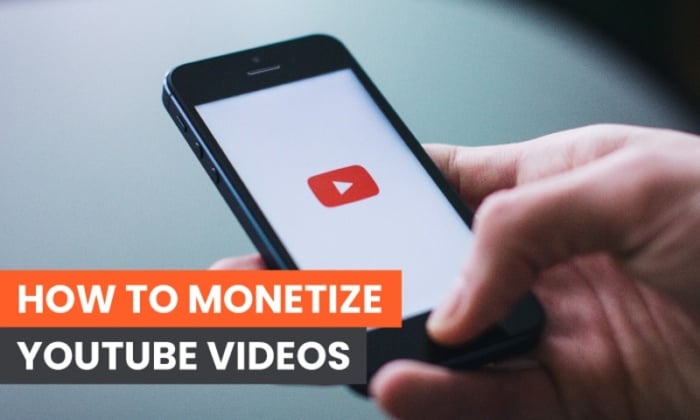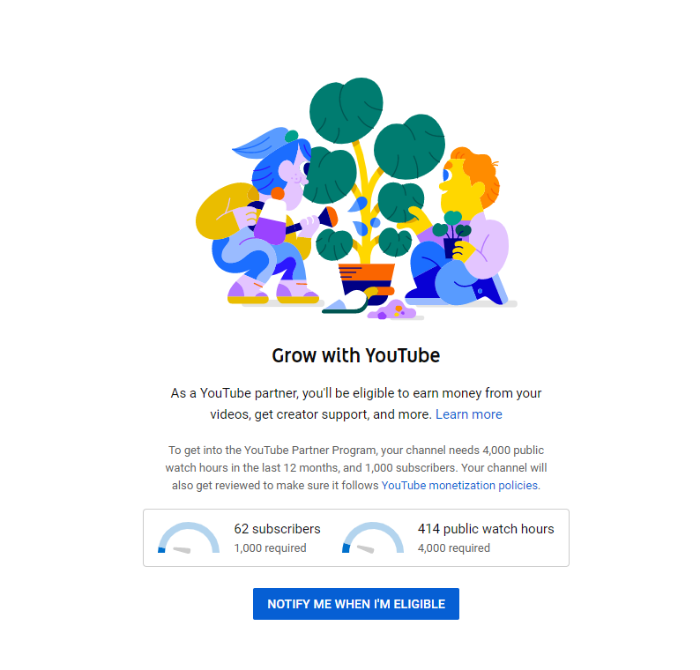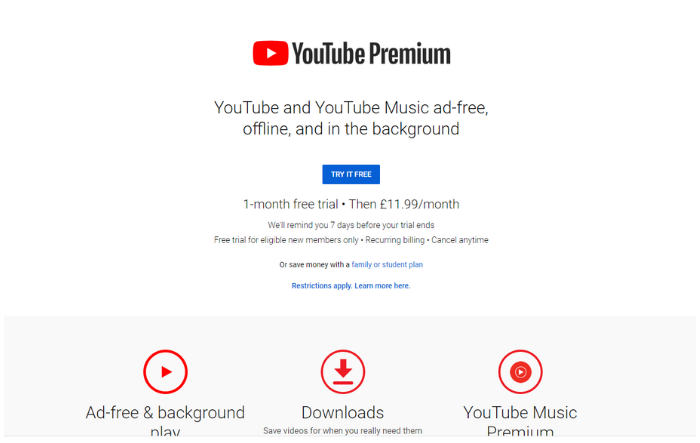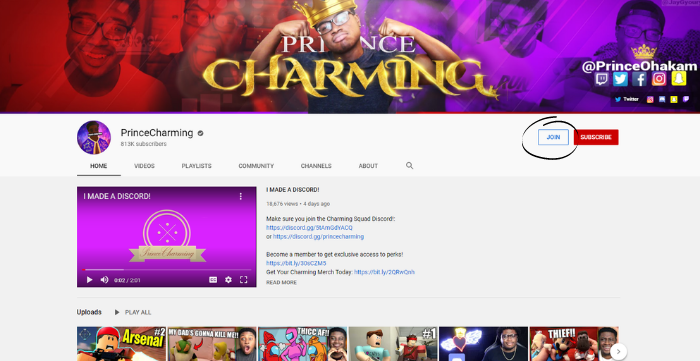
If you create a video that gets over 7 billion views on YouTube, you should be able to benefit in some way, right?
Now, you may not have the same level of success with your content as “Baby Shark Dance” did (7 billion and counting is a lot), but there are still plenty of ways to monetize your YouTube videos. You put time and effort into creating great content, so now it’s time to reap the rewards.
How to Monetize Your YouTube Account
Setting up your YouTube account with the YouTube Partner Program is very simple. You will see the monetization tab whenever you log into Youtube Studio, and when your account reaches the right number of subscribers and views, you’ll be able to apply to the program here.
Once you’ve applied to the program, your account will go into review and you should soon hear whether you’ve been accepted. From here, you can begin to monetize your account and continue growing your revenue streams.
All your analytics for things like advertising will be shown in YouTube Studio and AdSense, so check in regularly to see how you’re doing. This will also give you helpful insights into your performance and where you can make improvements.
What Are The Requirements to Monetize YouTube Videos?
The first step to monetizing your YouTube Videos is becoming a member of the YouTube Partner Program (YPP.) While anyone can create a YouTube account, you need to meet some basic criteria to become a member of YPP, and you must keep these requirements in mind whenever you create content.

First of all, your channel has to reach a couple of milestones before it can be considered for the program:
- 1,000 subscribers
- 4,000 watch hours over the past 12 months
These are fairly straightforward requirements, and they’re something you can work toward by creating great content and building your audience.
However, the more complicated aspect of joining the YPP, and the area where YouTube will spend time auditing your channel is making sure there is compliance with YouTube’s policies and guidelines.
YouTube has grown to become one of the most successful websites in the world, making over $5.5 billion in advertising revenue in the U.S. in 2020 but there are growing pains. Many of these difficulties have surrounded issues such as copyright and the quality and accuracy of content.
Brands who pay YouTube for advertising don’t want to be associated with low-quality content, so naturally, the platform is eager to ensure YouTube Partner Program members are creating unique, valuable videos.
You’ll need to keep in mind whenever you’re uploading content to YouTube, and it’s advisable to read these documents thoroughly if you plan on monetizing your videos.
Lastly, you need to set up a Google AdSense account, which will track the ads shown on YouTube and pay you accordingly.
7 Tips for Monetizing Your YouTube Videos
Just because you’ve reached a point where YouTube monetization is possible doesn’t mean you’ll instantly start making money. What you’ve got to ensure is that you continue following the principles that have got you this far.
Like with any publication, the key thing is that you continue to offer value to your target audience, so there are a number of things to focus on:
- Only sponsor products you would buy.
- Be consistent with your posting.
- Never compromise on quality.
- Take steps to understand your audience.
- Diversify your channels: Grow your other platforms such as blogs and social media.
- Reward your loyal followers.
- Use SEO to boost your profile.
If you’re going to make the most of YouTube monetization, then you’ve got to grow your profile in all areas, so make sure you’ve got a broad focus and are always looking to improve.
8 Ways to Monetize YouTube Videos
Just as there are many different ways to monetize your website, there are also lots of ways to monetize your YouTube videos.
Advertising revenue might be the most obvious way to earn money through your content, but it’s not the only way to monetize your videos, and different options will suit different creators.
For example, my YouTube channel gets over 7,000,000 views a month, but I don’t monetize it directly through the YPP. That’s because it’s more valuable to me to offer a clean experience through my content that brings people back to my website, where I own the medium.
However, everybody’s content is different, and they will have different ways of monetizing it.
1. Ad Revenue
Ad revenue is perhaps the first thing people think of when they join the YouTube Partner Program, and it can be an important revenue stream.
Once you are accepted into the YPP, you can immediately turn on ads for all videos that meet YouTube’s advertiser-friendly content guidelines. This enables adverts to be shown on your content, and when YouTube gets paid by advertisers, they share those earnings with you.
For each ad that’s shown on your channel, YouTube takes a 45% cut and you receive the remaining 55%. This money is then paid to you via Google AdSense, where you can keep track of all your analytics.
How to Turn on Ads
- Go to your YouTube Studio.
- Click “Content” in the left sidebar.
- Select a video or multiple videos.
- Click Monetization in the left sidebar.
- Select the type of ads you want to run.
- Save.
2. YouTube Premium
YouTube Premium is another revenue stream you qualify for as soon as you join the YouTube Partner Program, and it can help boost your earnings.

YouTube Premium is available to all YouTube account holders, and it offers users an upgraded experience. The big selling point for YouTube Premium is that it removes all ads, so people can watch their favorite videos without interruptions, and it also allows you to run the YouTube app in the background without the video pausing.
As a creator and YPP member, you get paid every time a YouTube Premium member watches your content, and as there are now over 20 million Premium members, this might be happening quite frequently.
You get paid automatically when a YouTube Premium member watches your content, so once you’re accepted into the YPP, you don’t have to make any changes to your account to benefit from this feature.
3. Channel Memberships
Channel memberships are very similar to monetizing your website through a membership program. This allows your members to pay a membership fee, and in return, they get access to special videos, live chats, emojis, badges, and other content.
Of course, you will still need to focus on your free content to help grow your channel, but this allows you to maximize your revenue on some of your best videos.

Channel memberships are a great feature to help you monetize your videos, but as you might expect, there are some extra requirements to unlock this revenue stream. You need more than 30,000 subscribers.
In order to charge people for private content, YouTube needs to be confident you’re offering value, and one of the ways it judges this is by looking at how many people subscribe to your channel. Once you’ve reached this milestone, you can easily enable channel members and start benefiting from this feature.
How to Turn on Channel Memberships
- Sign in to YouTube Studio.
- Select “Monetization” on the left sidebar.
- Submit your perks.
- Create your intro video.
- Choose your pricing structure (you can create multiple membership tiers, so you can hit many different price points).
- Post the “Join” button on your page.
Super Chat and Super Stickers
You may have tuned in to a livestream on YouTube and wondered how some people have managed to get their messages highlighted in the live chat. What they’ve done is purchase a super chat or super sticker that allows their message to be featured and even pinned to the top of the chat.
For viewers, super chat offers greater access to the brand they’re engaging with, and for content creators, it offers another revenue stream.
Users can spend up to $500 for super chat, and you keep around 70% of this, while YouTube takes the other 30%. As you might imagine, if you have a large audience watching a stream, then this can really start to add up.
If you’re new to livestreaming, then here are some of my favorite techniques for engaging with your audience so you can boost those revenues.
There are some geographical limitations on where super chat and super stickers are available, so make sure you’re in the right areas before getting set up with this great revenue stream.
How to Turn on Super Chat and Super Stickers
- Go to your YouTube Studio.
- Select “Monetization” in the left sidebar.
- From the top menu, select “Live Chat,” then “Get Started.”
- Follow the instructions until you see the message “Super chat status is on.”
Make Sponsored Content
Your options for making money aren’t just limited to the YouTube Partner Program.
You can also monetize your YouTube videos and make some good money through sponsored content. This involves reaching out to brands and offering to create videos that feature their products, and there’s a big market for this.
Companies are willing to pay good money to get their brands in front of a large, engaged audience, so if your videos are getting lots of views, then this option can become a primary monetization method for you.
A good way of finding companies to sponsor your YouTube content is YouTube BrandConnect, which uses an algorithm to match you with potential sponsors. Like every monetization method, how much you get paid will depend on the quality of your content and the number of viewers, but it’s certainly a good avenue to explore.
Crowdfund Your Projects
You’ve heard of crowdfunding for startups; well, you can use the same idea to fund your content creation on YouTube. With third-party applications like Patreon, you can find people to financially support the work you do in return for special perks.
For example, you might offer people early access to your new content in return for a $1-a-month subscription. You’re in control of the rewards, and the Patreon user decides how much they think your content is worth.
YouTube has also recently added its own crowdfund feature, where you can put a sponsor button on your videos. Just like with Patreon, this allows you to offer rewards to your audience in return for monthly funding. This option started for gaming channels, but is gradually being rolled out across more channels.
Sell Merchandise
If you’ve built a strong brand through your content, then chances are your audience might want to engage with it by buying merchandise.
When your channel reaches 10,000 subscribers or more, you can open up YouTube’s merchandise feature and create yet another revenue stream. This option might not be right for every channel, but it can bring in a substantial income for some YouTuber accounts.
With 1,000,000 YouTube views a month, it’s estimated that a good merch shelf can bring in between $4,100 and $21,460 a month, so again, it’s worth exploring.
How to Turn on Merchandise
- Go to YouTube Studio.
- Click “Monetization” on the left-hand menu.
- Click on the “merchandise” tab (it will only be visible if you’re eligible).
- Follow the instructions and receive your Teespring ID.
Become a Brand Affiliate
Affiliate links have long been a favored way for publishers to monetize their blogs and videos.
When you join an affiliate program, you can choose from a variety of products to sell, and every time someone buys a product through your unique link, you take a set percentage of the value of the sale.
Affiliate offers will vary greatly, and there’s a wide variety to choose from, but if you find products that match with your content, then it can be a good revenue stream. Affiliate marketing gets talked about all the time online, but if you’re looking for a few pointers, here are my ideas on when you should use affiliate marketing.
The easiest way to add affiliate links to your content is in the description. However, you can also add them directly into the video content itself.
When you’re doing this, remember that successful content always offers value, so any affiliate links you include have to be relevant and useful for your viewer. The products you recommend will reflect on you, so check that your affiliate links match the quality of your content.
Conclusion
If you’re creating amazing content that engages YouTube’s audience, then you should be rewarded for it, and this is where monetization comes in. There are now lots of different ways you can monetize your YouTube videos, and it’s possible to earn substantial money from it.
However, in order to benefit from YouTube monetization, you’ve got to work hard to build your audience and reach the minimum thresholds of 1,000 subscribers and 4,000 watch hours over the past 12 months.
This will take some work, but if you’re consistently creating great content, then it will come, and you can start to benefit from your hard work. With so many different monetization methods, there are plenty of ways for you to build a consistent income through YouTube.
How do you monetize your YouTube videos?
The post How to Monetize YouTube Videos appeared first on Neil Patel.
from Blog – Neil Patel https://ift.tt/2MLR9nV

No comments:
Post a Comment